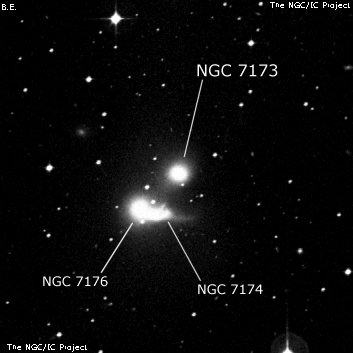
John Herschel discovered NGC 7173 = h3909 on 25 Sep 1834 and recorded "B; vS; R; sbM to a star." His position (measured on 4 sweeps) and sketch (plate IV, fig 11) matches ESO 466-039 = HCG 90C.
RNGC reverses the identifications of NGC 7173 and NGC 7174, making NGC 7173 and NGC 7176 the contact pair instead of NGC 7174 and NGC 7176, as described by Herschel. Sherburne Burnham measured accurate positions (Publications of Lick Observatory, II) and the galaxies were correctly identified. The identifications are also sorted out in my RNGC Corrections #1.
200/250mm - 8" (7/24/82): faint, small.
300/350mm - 13.1" (7/27/84): faint, small, round. Similar in size and brightness to NGC 7176 1.5' SE in a compact trio with NGC 7174 1.3' SE. Member of the HCG 90 = NGC 7173 group = Klemola 34.
400/500mm - 18" (10/21/06): fairly bright, fairly small, round, well concentrated with a very bright 30" core that increases to the center. The core is surrounded by a much fainter halo perhaps 45" diameter. In a trio with the contact pair NGC 7174/7176 1.4' SE.
18" (9/3/05): moderately bright, fairly small, round, evenly concentrated to a brighter core and quasi-stellar nucleus. Located 1.5' NW of the NGC 7176/7174 pair in HCG 90 and just slightly fainter and smaller than NGC 7174.
600/800mm - 24" (8/23/14): bright, moderately large, round, 45" diameter. Contains a relatively large, very bright core that gradually increases to the center. NGC 7174/7176 (contact pair) is less than 1.5' southeast. NGC 7172 lies 6' north. The quartet forms HCG 90 and the close triplet is KTS 66.
Notes by Steve Gottlieb